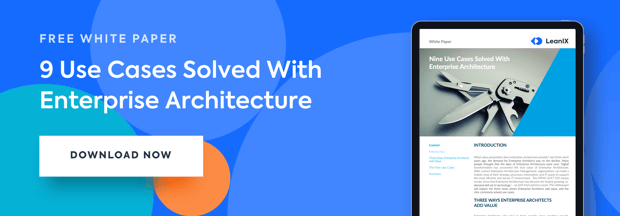
This blog was updated by Jenna Kominski in January, 2021
At first they appear innovative and inspiring, but every new technology is a potential risk if IT professionals don’t know the possible consequences of using them. According to Forrester’s Predictions 2021: Accelerating Out of the Crisis, due to the amount of employees working remotely from the Covid-19 pandemic, 33% of data breaches will be caused by insider incidents. Additionally, the global public cloud infrastructure market will grow 35% in 2021. That’s a lot of new technology.
With DevOps culture on the rise, IT professionals, enterprise architects, and business leaders alike should focus on making technology risk management during continuous delivery not just a task, but a lifestyle. A sound enterprise architecture (EA) practice is the key to consistently assessing new technology’s pros and cons.
What is technology risk?
The term "risk" can have various meanings, but in general is defined as the probability of loss or another negative occurrence caused by vulnerabilities. Businesses can avoid these losses by taking precautions against costly data breaches and IT outages. Businesses must pay attention to their susceptibility. According to research from Business Wire in 2020, 63% of IT leaders reported that technology management has become more difficult of the past year due to new, complex ecosystems.
The last few years have seen some of the most promising technologies emerge, such as cloud computing, artificial intelligence (AI), Internet of Things (IoT), and blockchain. But how can businesses know the risks of these new technologies?
Emerging technologies can increase complexity
The need to adopt emerging technologies is rapidly increasing, especially due to enterprises’ incessant pursuit of digitization. As the pace of digitization continues to accelerate, organizations are expected to move from ideation to product to revenue at rapid speeds. The fear of lagging tends to push all departments and business units in an enterprise to adopt technologies without first considering their functional or technical fit in the overall IT landscape.
Blindly adopting new, untested technologies will often complicate governance, collaboration, and transparency efforts thereafter. The result: heightened business risk developed from a lack of alignment between processes and technologies. These risks bring the potential to diminish returns, increase costs, and paralyze growth. As the practice persists, the silo effect grows, exacerbating the effect on the enterprise’s top and bottom-line efforts.
The rise of risk: What to do?
According to our 2019 Enterprise Architecture Insights Report, cloud computing, IoT, and AI are the top technology architectural trends increasing the IT landscape’s complexity. For example, using a cloud native environment requires IT professionals to keep track of cloud spend, control complex dependencies, and detect any violations that could affect the cloud landscape. The increasing usage of emerging technologies is reflected in the fact that 36% of enterprises are already using three or more technology architectures.
A necessity for emerging technologies should not get in the way of rational approaches to adopting new technology. Enterprises must follow a thorough process to select, invest, and deploy these new tools or platforms. In the long run, this assessment can act as an engine of competitive differentiation when determining profits, losses, market value, and brand perception.
Using enterprise architecture to ensure transparency
Risk management processes require visibility into an enterprise’s various business capabilities and procedures, in addition to the underlying IT landscape. Using an EA tool to manage risk ensures that enterprises have a transparent view of IT assets and a collaborative approach to working with stakeholders involved in IT decision making.
For example, the LeanIX Enterprise Architecture tool helps uncover crucial information for technology risk management, such as:
- What technology standards are in use across the enterprise
- Where are IT Components located
- How well do IT assets adhere to security standards
Why use LeanIX to manage risk?
According to research from PwC, 55% of 1,500 security and IT chiefs expect their organizations’ spending on cyber security to increase in 2021.
EA tools play a massive role in technology risk management, as they assist with:
- Getting an up to date view of the entire IT landscape
- Identifying redundant applications and IT components
- Promoting stakeholder's collaboration to identify and mitigate risks
- Defining standards and principles
- Ensuring the IT landscape is compliant with the regulatory environment
In the end, technology risk affects every business, no matter how experienced the IT team is. Our white paper 9 Use Cases Solved With Enterprise Architecture further explores how enterprise architecture can manage technology risks to save costs, time, and energy.







